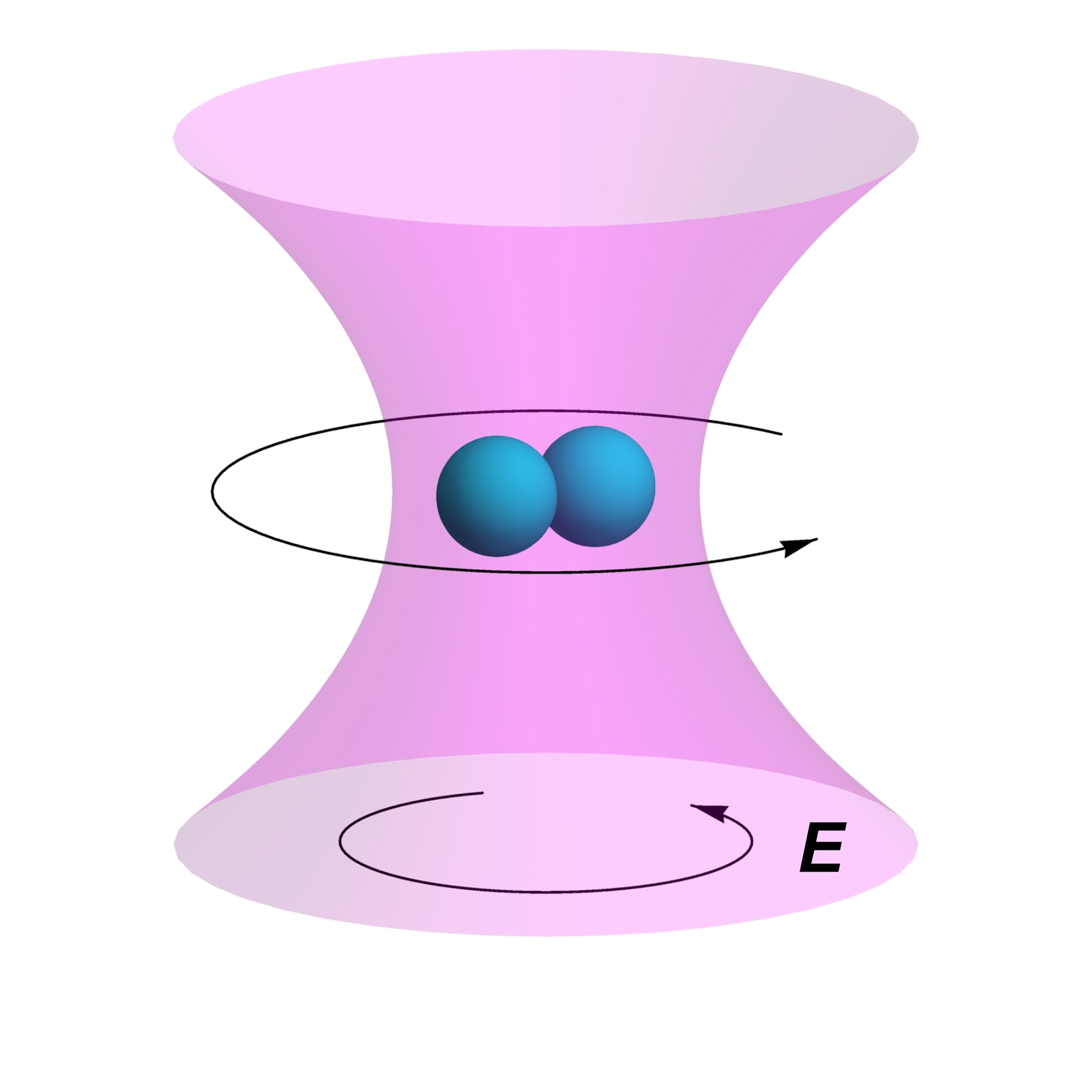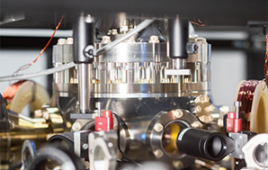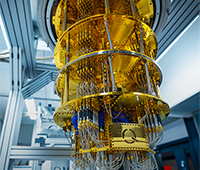
(Click to view animation) Purdue University researchers have created the fastest man-made rotor in the world, which they believe will help them study quantum mechanics. (Credit: Courtesy of Purdue Engineering)
The National Quantum Initiative Act was signed into law by Congress last year to advance coordinated research efforts in quantum information science—the study of the smallest particles and how they can be manipulated—to secure the nation’s preeminence in the tech economy and national security. Why? Quantum computing has the potential to be a game-changer in everyday life.
With research in quantum information science strong and accelerating at Purdue University, a new Quantum Science and Engineering Institute was formed to coordinate and incentivize university-wide activities and establish a new resource for faculty and students working on and interested in the pivotal field, which may lead to an array of advanced technologies and products.
“Quantum information science has become one of the most rapidly developing and game-changing areas in science and technology, promising many revolutionary advances in the coming decades,” said Tomás Díaz de la Rubia, vice president for Discovery Park at Purdue. “Quantum information science is a defining technology for the future, and a strong, early and coordinated multi-sector focus on these technologies is essential for the U.S. to sustain its economic and national security leadership.”
The new institute will help grow and support quantum information science and engineering research across campus, with numerous faculty members in various disciplines, primarily in the colleges of Science and Engineering. The inaugural institute director is Yong P. Chen, a professor of physics and of electrical and computer engineering, and associate director of the Birck Nanotechnology Center in Purdue’s Discovery Park. The Institute will be headquartered in Birck, which also houses various research programs ranging from nano/quantum photonics to nanoelectronics and spintronics.
In 2015, the Purdue Quantum Center, the precursor to the new institute, was co-founded by Vladimir Shalaev, the Robert and Anne Burnett Distinguished Professor of Electrical and Computer Engineering and leader of the College of Engineering Quantum Photonics Preeminent Team; and Chris Greene, the Albert Overhauser Distinguished Professor of Physics and Astronomy. Since 2016, Chen has directed the Purdue Quantum Center.
Researchers are plumbing the realm of quantum mechanics, which attempts to describe the non-intuitive behavior of physical systems at the atomic and subatomic levels.
“Quantum science is experiencing a surge of interest as researchers, students and industry leaders across the globe race to build a truly usable quantum computer, a machine that will be able to process unimaginable amounts of data at exponentially faster rates than today, transfer and store information with advanced cryptography, and facilitate new discoveries and myriad other applications,” Chen said.
In a traditional computer, a “bit” of information is either a one or a zero, on or off. Each bit can only exist in one state at a time. However, a quantum bit, or “qubit,” can be both a one and a zero at the same time, due to the quantum phenomenon of “superposition.”
“This effectively doubles the computing power of one traditional bit,” Shalaev said. “Two qubits together can represent four scenarios at the same time, three qubits represent eight scenarios, and so on. The computing power thus grows exponentially with the number of qubits.”
Another feature of quantum mechanics that can be exploited is “entanglement,” what Albert Einstein called “spooky action at a distance.” Entanglement is a phenomenon that shows that particles can be linked together, and the effects of manipulation of one particle are shown in the other, no matter the distance between them. If harnessed for technology, entanglement could bring advanced computers, communication systems and sensors with unprecedented capabilities.
Purdue has many experts in the field, and about 30 faculty members will be involved in the new institute.
“For example, a group led by physics professor Michael Manfra who also directs a Microsoft Station Q lab at Purdue, grows and studies ultra-pure semiconductors and hybrid systems of semiconductors and superconductors that may form the physical platform upon which a quantum computer is built,” said Patrick J. Wolfe, the Frederick L. Hovde Dean of Science.
In the College of Engineering, researchers are one step closer to “unhackable” communication, in work led by Shalaev.
“Using entangled states, light and matter are so sensitive to disturbance, it would be virtually impossible for a hacker to do their work undetected in a quantum system,” said Mung Chiang, the John A. Edwardson Dean of the College of Engineering. “Professor Shalaev’s Tellabs Preeminent Team on Quantum Photonics in the College of Engineering has created a new technique that increases the secret bit rate of single photons to allow for sending much larger pieces of information at faster rates than has been previously demonstrated.”
Other promising areas of research include work to develop “spintronics” devices for future computers; new materials and energy technologies; quantum sensors and other quantum technologies for industry and medicine; and data analytics. A YouTube video of work being done at Purdue is available here.
“As such, the institute will work closely with other centers to support all the major Discovery Park strategic ‘impact’ themes – health, sustainability, and security,” Díaz de la Rubia said. “The institute will be able to effectively support, connect and grow quantum related research over the whole Purdue campus, and coordinate across diverse disciplines and colleges.”
The institute’s goals dovetail with the nation’s recent focus on quantum science. Congress has passed the National Quantum Initiative, aimed at maintaining U.S. leadership in the field.
“I commend Congress for passing the National Quantum Initiative Act, with plans to invest well over a billion dollars in quantum information science research over the next 10 years,” Díaz de la Rubia said. “Developing quantum systems is hard, it’s a scientific and an engineering grand challenge, and we need a clear strategy and significant resources to stay in front of our international competition, develop and take advantage of these amazing new technologies, and be the first to market. The national security and economic security of the United States demands it.”
The private sector and academia need to tightly integrate basic research and engineering to create practical quantum computers and other quantum information systems and technologies, he said.
In addition to various federal agencies ramping up funding for the field, leaders of various tech giants such as IBM, Microsoft, Google and Intel, as well as numerous new startups, are developing the technologies to build the quantum computers and systems of the future.
“These efforts include very interesting and effective partnerships with universities such as Microsoft’s alliance with Purdue, and an alliance with the newly created entanglement institute” Díaz de la Rubia said. “Public-private partnerships will need to provide test beds and benchmarking mechanisms for new technologies as they are developed. These complement well with Purdue’s strong and increasing collaboration with national labs, which play very important roles with their state of the art facilities and unique expertise in quantum related fields.”
The program aligns with Purdue’s Giant Leaps 150th-year anniversary celebration, acknowledging the university’s global advancements made in health, longevity and quality of life as part of Purdue’s 150th anniversary. It also highlights Purdue’s leadership in AI, algorithms and automation, one of the four themes of the Giant Leaps Ideas Festival. As part of the Ideas Festival and to kick off the new Purdue Quantum Science and Engineering Institute (PQSEI), an International Symposium for Quantum Science and Technology will be held from April 22-23 in Purdue, bringing about 20 world leading experts to campus to discuss frontiers of quantum research.



